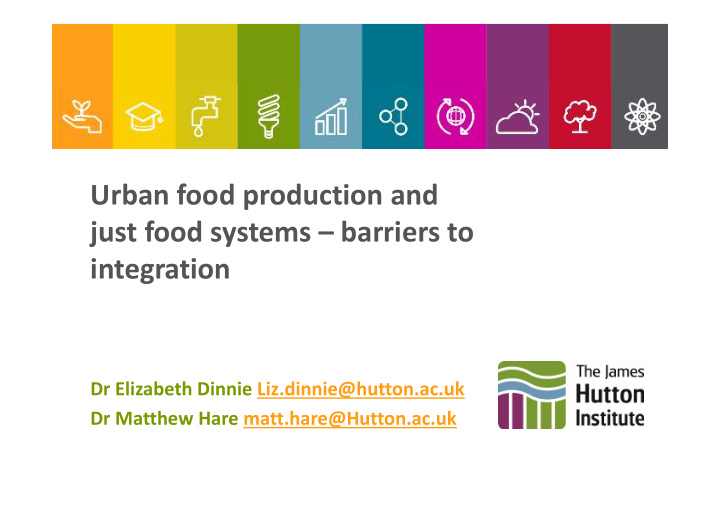



Urban food production and just food systems – barriers to integration Dr Elizabeth Dinnie Liz.dinnie@hutton.ac.uk Dr Matthew Hare matt.hare@Hutton.ac.uk
Urban food growing and just food systems Urban food growing has multiple benefits But can it contribute to food justice?
Why food poverty? Increasing concern with HH food security and food poverty in food secure countries Public and policy unease over foodbank use Are there alternatives?
Urban agriculture and food security Food systems connect food poverty with societal issues such as low income, poor food practices/choices, poor food environment, high food prices Despite increasing, urban agriculture/food growing is not tackling household food MH1 security (REF your work?) Could growing your own? help to create a more just and secure food system?
Slide 4 MH1 would it help to talk about local food systems? and add refs? Matthew Hare, 03/07/2019
Hypothesised systemic barriers to local food growing and food security resource biases local food systems can end up being dominated by people of higher economic status (Macias, 2008); Policy Food growing is framed through spatial planning and not economic strategy Meaning that it falls under environmental services not economic growth, nor food provisioning Research Favours agricultural systems and innovation Some reject community gardnes as facilitator of neoliberal rationalities institutional biases the promotion of local food initiatives is the remit of the council’s environment department; Market bias Economies of scale are not available to small scale producers They are forced to produce premium, niche products rather than affordable staples Cultural Expectations for ‘clean’ blemish free food, plastic wrapped
Objective: Re-Forging the Link between Urban Agriculture and Food Poverty carry out a transdisciplinary diagnosis of the importance and impact of barriers and drivers ... in all their interconnected complexity co-construct an integrated strategy for re- forging the link in Aberdeen
Methodology - diagnosis Participatory systems modelling (Hare, 2011) workshops with different stakeholder groups Local government Planning, social services, environment Low income householders Local food system networks Researchers In situ co-creation of a causal loop model of the complex system (Vennix, 1996)
Systems Modelling Precedents Food supply, value, and decision chains (Gudbrandsdottir et al. 2018) Water resources management Pahl-Wostl & Hare (2004); Daniell et al (2010); Community-based climate change adaptation planning Hare et al (2014); Camacho et al. (2018)
A researcher’s causal loop model of local food systems and their link to healthy diets for low income households
A researcher’s causal loop model of local food systems and their link to healthy diets for low income households Habits and history Use of Time Food Choices Diet Other needs & spending priorities
A researcher’s causal loop model … Tastes, habits Household budget sufficient time Healthy food landscape Transport Access to & Purchase of fresh food
A researcher’s causal loop model … Unhealthy food landscape Gig economy Tastes, habits Purchase of convenience POOR foods Household budget INsufficient time Healthy food landscape Transport Access to & Purchase of fresh food
A view of a support worker – impact of community gardens Community Garden Grow your own
A view of a support worker – impact of Small properties community gardens -No garden Problems of culture poverty Vandalism No volunteering Community Garden Grow your own
The next TWO SLIDES RE MEXICO - #16 and 17 are OPTIONAL before summary slides
A model of dystopic transition from 3 rural to peri-urban livelihoods in Mexico Hare, Pena del Valle, & Perez (2019)
Models of In-Migrants to Peri-Urban Zones in Mexico Despite growing your own still a habit and knowledge widespread Poor housing lack of growing space Low wages multiple jobs lack of time for growing and preparing fresh food Community cooperation dying out Vandalism and insecurity Change of government, end of community garden
Summary Increasing levels of urban agriculture are not necessarily translating into reduced food poverty What can be done to forge the link? Transdisciplinary participatory modelling to co- construct a strategy, based on the multi-sectoral complexity of the problem OPTIONAL: Certain similarities in dynamics between Scotland and Mexico – even food growing know-how not enough
Not only is access to land a problem … “Near landless” Ownership of land, but no real control over its use Borras, jr, S.M., and Franco, J. (2018) The challenge of locating land-based climate change mitigation and adaptation politics within a social justice perspective. The Third World Quarterly, 39(7) pp. 13081325 “Near time-less”, as well? For support workers as well “There are mair important things, than helping poor families grow fruit and tatties”
This work at the James Hutton Institute is funded by …. the Macaulay Development Trust, Macaulay Research Fellowship on Socio-Ecological Modelling (2017-2020)
Recommend
More recommend